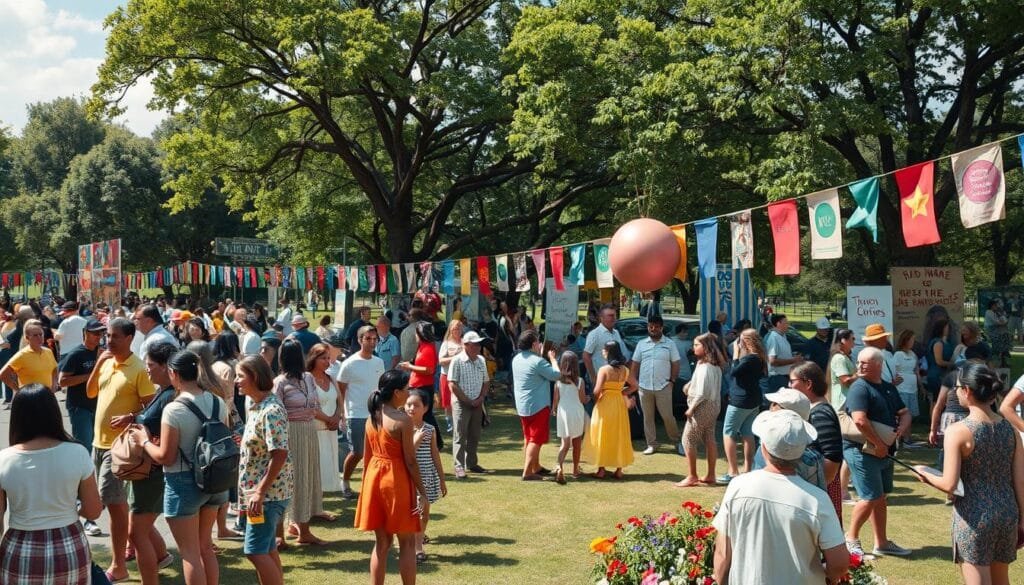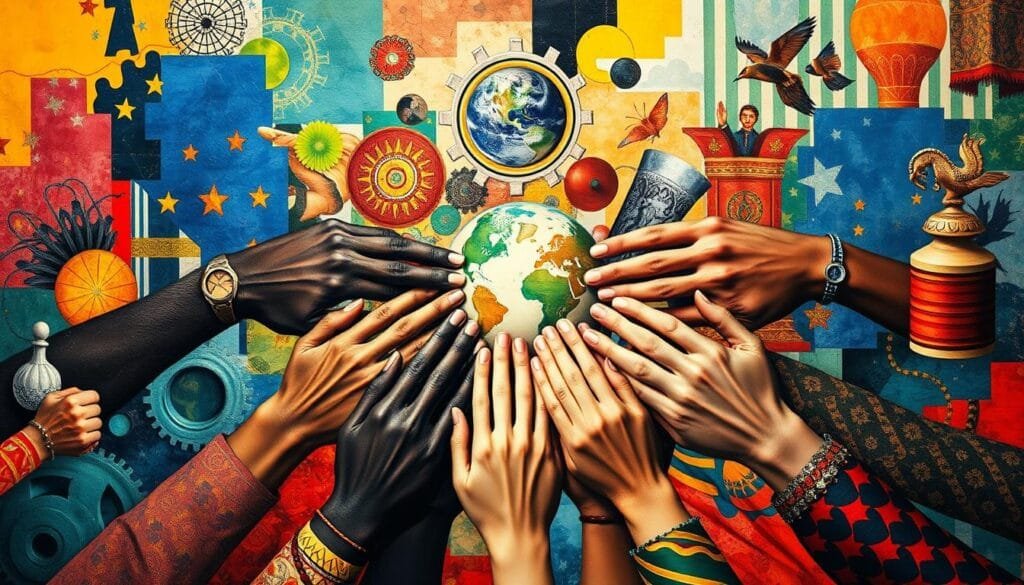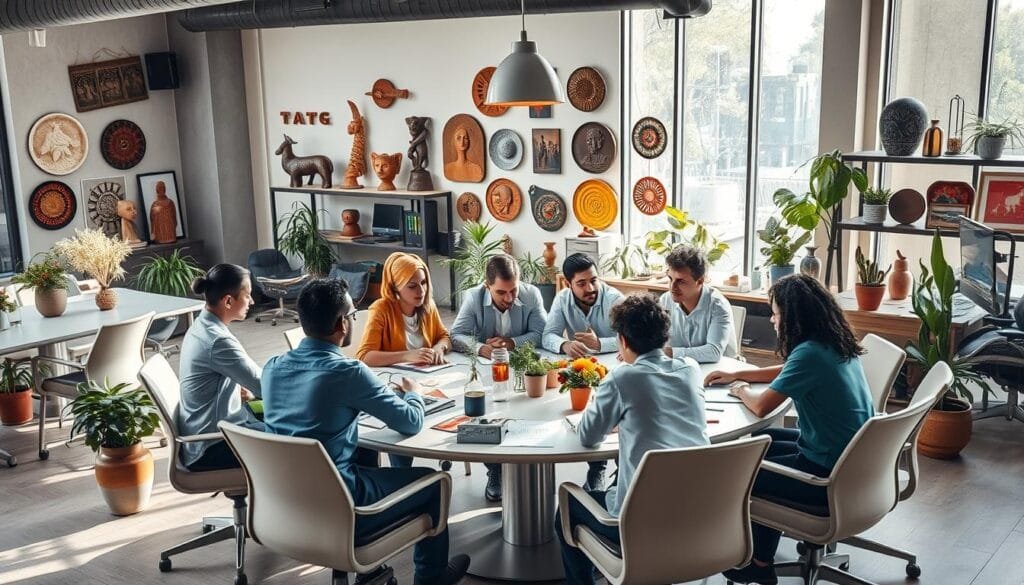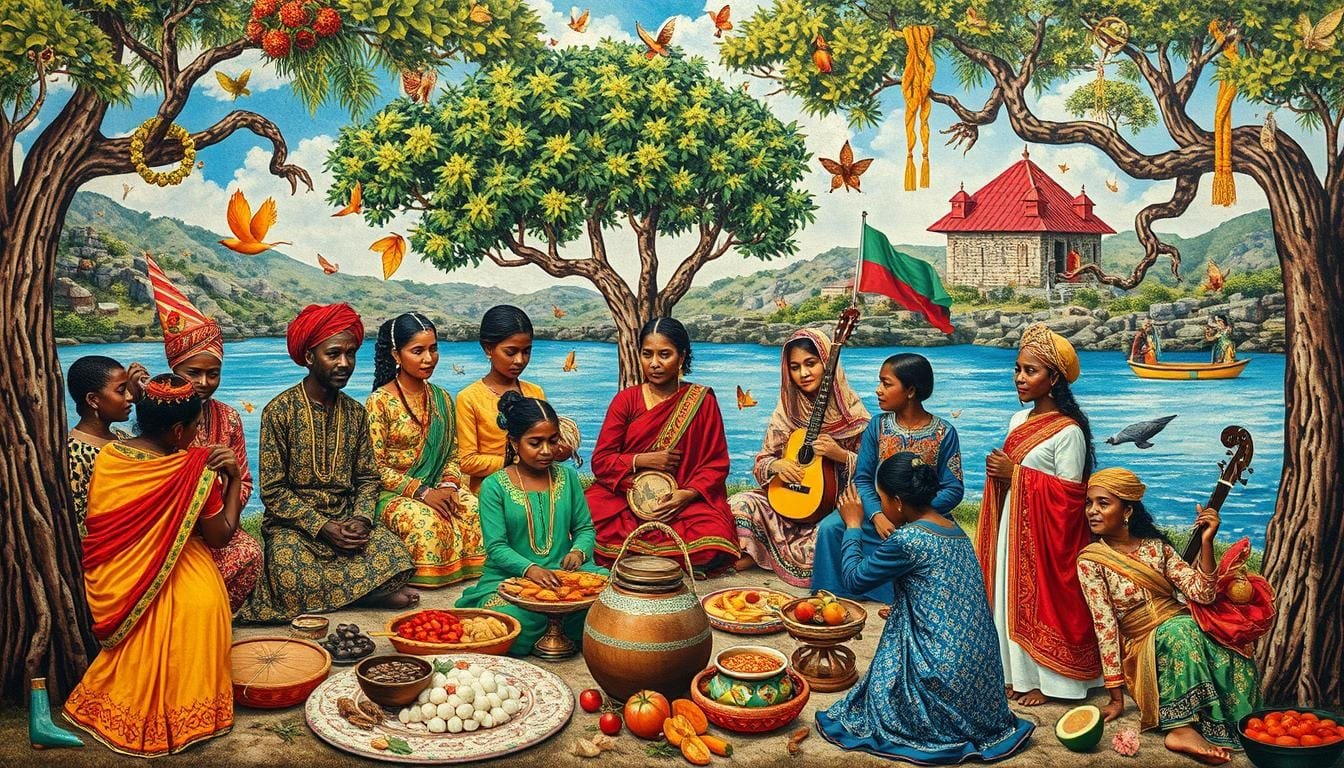Imagine a world with around 195 countries and over 7,000 languages. Do we stop to think about the cultural meanings in our daily lives? The variety is amazing, yet many overlook how cultural knowledge can improve our relationships and community connections. Could learning about cultural actions be the secret to better interactions worldwide?
Studies show that students do better in school when their culture is respected, with up to a 20% grade boost. In communities, diverse groups reach goals 30% more effectively than those in isolation. These facts show how crucial cultural understanding is in our daily lives and for anyone working with community projects.
Understanding different cultural signals helps avoid misunderstandings and builds cooperation. It creates a place where everyone feels they belong. It’s not just theory; it’s practical. It helps us connect better and makes communities more active. In fact, places that focus on diversity see a 50% rise in community involvement.
Key Takeaways
- Cultural understanding and appreciation can improve academic performance by up to 20%.
- Diverse groups achieve common goals up to 30% more effectively than homogenous groups.
- Community engagement increases by 50% in areas recognizing cultural diversity.
- Cultural conflicts can consume 25% of community resources, underlining the need for cultural competence.
- Effective cross-cultural interactions and community building hinge on understanding cultural differences.
What Is Culture?
Culture involves the social behavior, norms, beliefs, and practices of people. These are learned from society. They affect individuals and entire societies by influencing our views, actions, and values. Understanding what culture is and its deep impact is key. It helps us appreciate our roles in society. It also encourages a more unified and welcoming community.
Definition and Scope
Culture means shared beliefs, values, customs, and behaviors that are special to different areas. This includes places like the Mediterranean, East Asia, or North Europe. The 2021 Australian Census showed that around 48% of Australians have at least one parent born elsewhere. This highlights Australia’s rich cultural mix. Over 300 languages spoken show the wide-ranging influence of culture. We see this in languages, social norms, and practices that get passed down through generations.
The Role of Culture in Our Lives
Culture plays a big role in our lives. It shapes how we see the world and interact with others. It influences our personal identity and how we fit into society. For example, a 2020 survey revealed that 79% of Australians think multiculturalism boosts societal values. This suggests that interacting with various cultures can deepen our understanding. It leads to richer interactions.
Furthermore, 64% of Australians have had meaningful conversations with people from other cultures. This shows how important cultural awareness is for stronger community relationships.
| Aspect | Insight | Statistics |
|---|---|---|
| Multicultural Population | Australia is one of the most multicultural countries. | 30% born overseas |
| Cultural Diversity | Diverse societal roles and languages spoken. | 300+ languages |
| Cultural Value | Enhanced societal values through multiculturalism. | 79% value |
| Inter-Cultural Relationships | Meaningful interactions with diverse cultures. | 64% engage |
The Importance of Understanding Culture in Community Building
Understanding culture is key in building strong communities. It helps make social ties stronger and stops conflicts from starting. Learning about different cultures makes everyone feel included and cuts down on ethnic and racial divides. This also helps communities work better together towards shared goals. Let’s look at how knowing about cultures affects our community and stops division.

Enhancing Relationships
Cultural understanding keeps communities together. It makes us respect and communicate openly with people who are different from us. Many big companies have seen their relationships and innovation grow after embracing cultural diversity. This has helped them grow by over 70%.
Developing Cultural Intelligence (CQ) can stop about 60% of business issues in global settings. Companies that focus on diversity and inclusion do 35% better financially than their peers. Teams that exchange cultural experiences work better together, showing a 30% boost in trust and teamwork.
Preventing and Overcoming Divisions
Stopping divisions is crucial for resolving conflicts well. By listening to diverse cultures, we can adapt our actions by 40%. This leads to better interactions across different cultures. Companies that train their staff in cultural awareness see half as many conflicts because of cultural mix-ups.
Understanding cultural aspects, like Hofstede’s Dimensions, is crucial in resolving conflicts. For example, the U.S. values individualism highly, unlike Japan, which values the group more. Knowing these differences helps us solve conflicts better, making communities stronger and more welcoming.
| Aspect of Cultural Understanding | Impact | Statistics |
|---|---|---|
| Employee Satisfaction and Retention | Improves employee well-being in a diverse workplace | Up to 25% increase |
| Diversity and Inclusion Initiatives | Boosts financial performance | 35% higher likelihood |
| Cultural Awareness Training | Reduces conflicts | 50% drop |
| Team Cohesion | Enhances collaboration and trust | 30% increase |
| Adaptation in Behaviors | Improves cross-cultural engagement | 40% enhancement |
How to Interpret Actions of Different Cultures
To understand cultural actions well, we need to really focus. By learning cultural norms and talking respectfully with people, we can get along better in different societies. Adding to our knowledge of these practices makes us better at connecting with various cultures.
Observing Cultural Norms
It’s crucial to know cultural norms to respect and understand different cultures. These norms affect how we see things and solve conflicts, often without us knowing. Things like age, social class, and politics can make understanding cultural identity more complex. For instance, a senior Chinese man in Canada said he lived 40 years without conflict, showing how culture affects conflict views.
Sometimes, the main cultural groups may think their way is the only way. This can cause misunderstandings in relationships. That’s why we must watch and think about cultural actions with an open mind. Paying close attention helps us interpret actions the right way. You can learn more about it here.
Engaging and Asking Questions
It’s important to connect with different cultures in a thoughtful way. Asking questions gently helps us understand various cultural practices. For example, what seems problematic in one culture may be normal in another. Joining in different cultural activities teaches us to see past our biases. This improves our empathy and listening skills.
The table below shares some important facts on why cultural knowledge matters:
| Statistic | Insight |
|---|---|
| 70% of employees | Believe that cultural awareness training is important at work |
| 50% of employees | Have faced miscommunication because of cultural differences |
| Cross-cultural collaboration | Can make project results 30% better |
| 75% of respondents | Felt that understanding cultures improved workplace relationships |
These facts show the need for cultural understanding and respectful communication to improve global teamwork and create a welcoming environment. Talking with people from different groups and paying attention to their ways helps us form strong, united communities.
Core Cultural Competencies for Professionals

Professionals need to master core cultural skills to thrive in varied workplaces. These skills are crucial for professional growth. They make sure cultural sensitivity is part of everyday work. Key skills include understanding oneself, knowing other cultures, and having the right clinical skills.
Self-Knowledge
Understanding our own culture is the first step. It means looking closely at our cultural biases and beliefs. We must know our own history and culture to avoid bias. This helps us connect better with people from other backgrounds. It builds empathy and understanding.
Cultural Awareness
Being culturally aware means understanding and valuing others’ cultures. We must learn about various cultural practices and values. Cultural awareness is a foundation for respecting diversity. It sets the stage for a welcoming environment. By getting this, we can handle cultural interactions better.
Culturally Appropriate Clinical Skills
In healthcare, having the right clinical skills for diverse patients is key. Experts like Betancourt advise tailoring care to fit cultural backgrounds. This involves understanding cultural health beliefs and values. Adaptations in care delivery are often needed. This approach improves care and the patient experience.
| Core Cultural Competency | Elements | Impact |
|---|---|---|
| Self-Knowledge | Evaluation of own biases | Improves empathy and reduces prejudice |
| Cultural Awareness | Understanding diverse backgrounds | Fosters inclusivity and respect |
| Culturally Appropriate Clinical Skills | Tailored patient care | Enhances treatment efficacy and patient satisfaction |
Cultural skills are about growing in awareness, knowledge, and ability. By embracing cultural sensitivity and ongoing learning, we build a welcoming and respectful work environment.
Creating a Culturally Inclusive Environment
Creating a culturally inclusive space requires effort from both the organization and its leaders. This effort not only welcomes diversity but also creates a supportive environment. Everyone feels important and heard. Focusing on inclusivity leads to better morale, higher productivity, and more innovation.

Organizational and Administrative Support
For diversity to thrive, organizations must fully support it. They should celebrate cultural holidays, respect different religious practices, and provide resources fairly. Acknowledging the importance of inclusivity boosts growth and satisfaction. For example:
- Providing cultural competence training for all staff.
- Implementing mentorship programs that pair employees from diverse backgrounds.
- Setting up employee resource groups to foster a sense of community.
A Glassdoor survey found that 67% of job seekers value workplace diversity. So, organizations need to actively champion diversity to attract and keep top talent.
Inclusion and Accessibility
Inclusion and accessibility are key for a truly inclusive workplace. Making spaces accessible and mindful of diverse needs allows everyone to fully engage and contribute. Strategies for this include:
- Adjusting communication styles to be more inclusive.
- Redesigning office spaces to accommodate individuals with disabilities.
- Encouraging the use of inclusive language that respects all cultures.
In higher education, inclusive classrooms improve experiences for students and staff. They lead to better grades and less stress. Continually challenging our own views on diversity and encouraging respectful student interactions can strengthen cultural inclusivity in education.
Here is a comparison of the effects of inclusivity on organizational performance:
| Impact Area | Inclusive Workplaces | Non-Inclusive Workplaces |
|---|---|---|
| Employee Engagement | High | Low |
| Innovation Revenue | 19% Greater | Standard |
| Turnover Rates | Decreased | Increased |
| Productivity | High | Low |
By making fairness a core part of their operations, organizations and schools can build respectful cultures. This creates a place where everyone, regardless of their background, can thrive and succeed.
Building a Diverse Cultural Community
Creating a diverse cultural community means making a space where many cultures live together in harmony. We need to set clear, reachable goals for inclusivity. And work hard to bring different cultural views together. This makes our community richer, where everyone feels they belong and respects each other. To turn this dream into reality, we must use smart ways to connect, understand cultural details, and always look to get better.
Envisioning Your Cultural Community
Imagining a diverse cultural community means thinking about how to involve minority groups properly. This takes special ways of reaching out to meet cultural standards that may affect how people join in and give feedback. For example, some women might not speak up freely due to their cultural backgrounds. This calls for research and adapted ways of communicating.
We need to build good relationships with various cultural groups to get their honest feedback. This takes time to plan, talk, and give updates. And involves working with leaders from these groups to get more people involved. By doing this, we build trust and teamwork, making a strong base for our diverse community.
Starting the Process
There are a few solid steps to start making a diverse cultural community:
- Identify Barriers: Look into cultural backgrounds to find and address barriers to getting involved.
- Creative Engagement: Use pictures and online methods in various languages to help people join in, especially if English isn’t their first language.
- Community Events: Host events like coffee meet-ups for minority groups to boost involvement and interest.
- Ongoing Communication: Keep talking to community members even after projects start to maintain strong relationships.
Understanding how to integrate cultures and meeting the needs of our community members is key to successful community building. By focusing on inclusivity and using the rich perspectives from different cultures, we can foster a place of teamwork, creativity, and respect.
Conclusion
Wrapping up this guide, we see that knowing about cultural actions is key for embracing diversity and unity. In a world where businesses are going global, it’s vital for companies to be culturally aware. This awareness bridges the gap between communities and improves relationships.
The Society of Human Resource Management (SHRM) states that cultural differences impact how productive a business can be. Thus, training in diversity and inclusion is important for readying employees for a diverse economy. By adopting anti-discrimination policies, companies ensure fair treatment for all employees, making for a welcoming workplace.
Celebrating different cultural and religious holidays can reduce misunderstandings, leading to a more supportive work environment. It’s important to communicate well to avoid confusion, as cultures have their own ways of greeting and talking. A workplace that values cultural awareness will likely have happier employees and better results. To learn more about cross-culture in business, click here.
FAQ
What is culture?
Culture includes the ways people behave, what they know, and what they believe. It is learned from living in society. It shapes how people see the world, act, and react to different situations. Culture is key to forming personal and group identities.
Why is cultural understanding important in community building?
Knowing about culture helps build stronger communities. It brings people together and stops conflicts before they start. Appreciating cultural differences cuts down on divisions and helps everyone work together better. This makes for a stronger and more inclusive community.
How can we interpret the actions of different cultures accurately?
To understand cultural actions well, we should closely watch and learn about different cultural norms. Talking respectfully with people from various cultures gives us more insight. This helps us understand each other better and avoid cultural misunderstandings.
What are core cultural competencies for professionals?
Professionals should know their own biases and work to overcome them. They need to learn about the cultural backgrounds of their clients. They also must have the right skills to work well with people from different cultures. This helps them serve their clients better.
How can organizations create a culturally inclusive environment?
Organizations should support diversity through their policies. They need to make sure everyone feels respected and valued. Making the workplace sensitive to cultural needs helps everyone feel like they belong. This makes a better and more inclusive environment for all.
What steps can we take to build a diverse cultural community?
To make a diverse community, we must aim for a place where different cultures live together peacefully. We should set clear goals for being inclusive. Then, actively include various cultural views. This will make our community richer and more unified.
